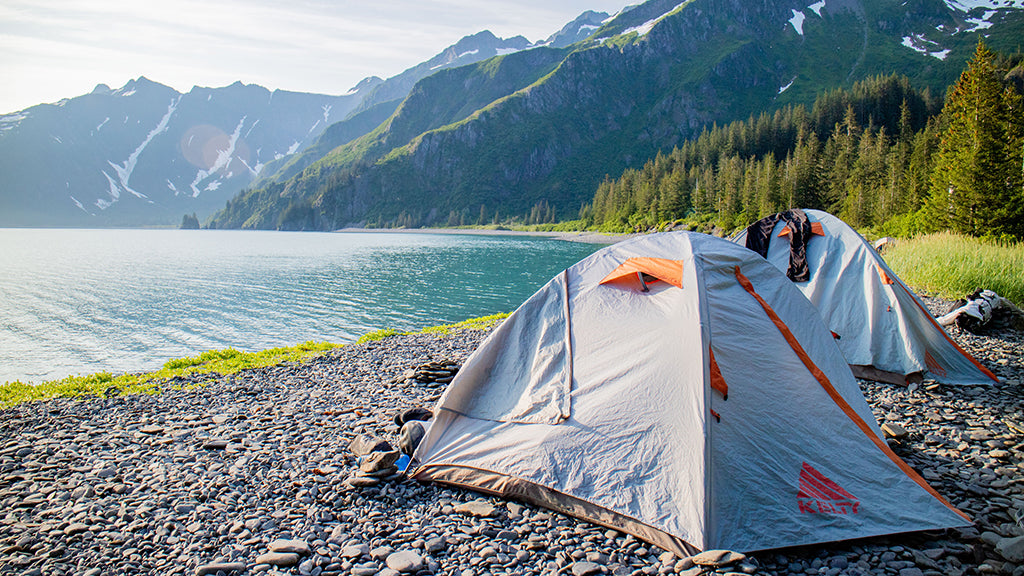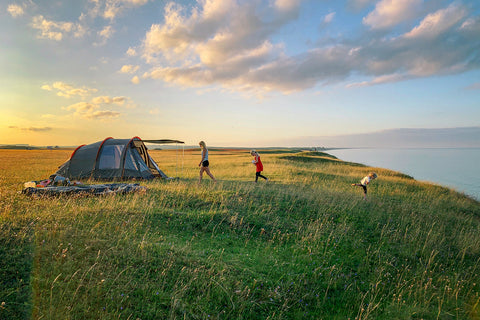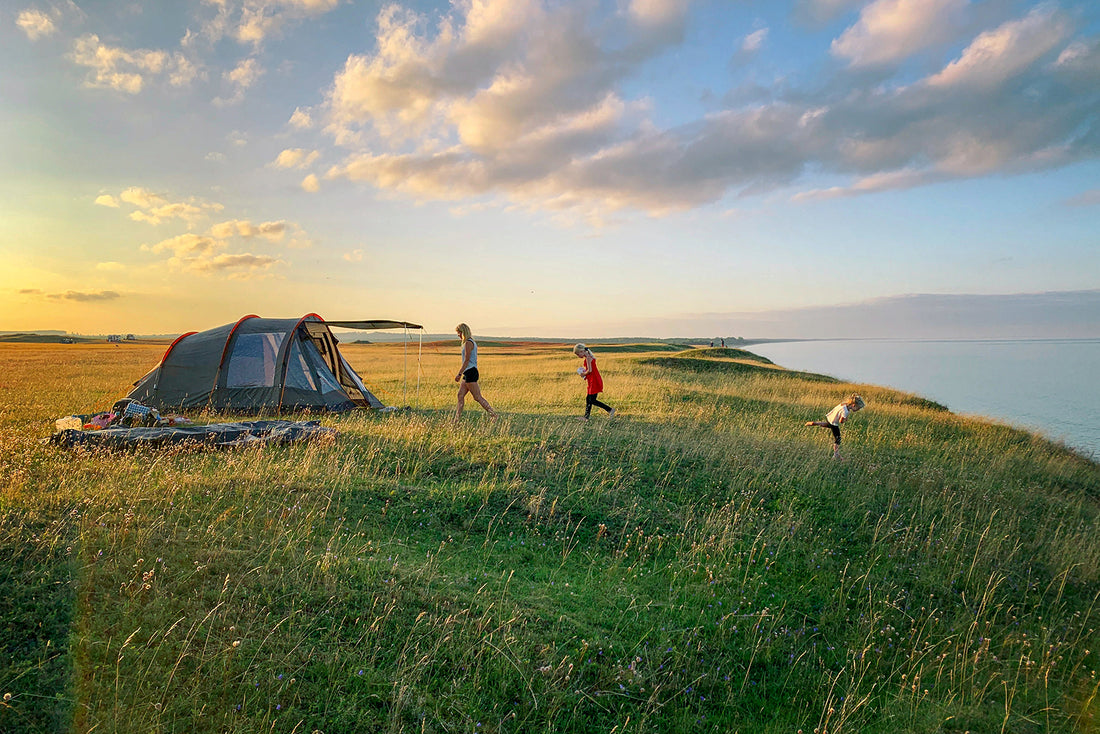How to keep warm when camping is perhaps one of the most important considerations. No one wants to sit in their tent, freezing cold, struggling to maintain their body temperature! Nor do we want to wake up in the morning with stiff joints and a sniffle.
It's essential to keep warm when camping. Firstly, for your comfort and enjoyment. Camping can be tough at the best of times – trying to enjoy your experience whilst freezing cold only makes things worse! Secondly, cold can have a negative impact on your health. In serious cases, it could lead to hypothermia and a lack of energy or the ability to function.
In this guide, I discuss thirteen essential tips for how to keep warm when camping. After reading the article, you should be confident in your warmth-keeping abilities, ready for your next outdoor adventure – enjoy!

Always Dress in Layers
The simplest piece of advice I can give when looking at how to keep warm when camping is to dress in layers. This might sound like a faff, but it is proven to work and it is the best way to adapt to different temperatures and keep your core temperature up.
You should have a base layer that sits next to your skin. In colder weather, this should be thermal gear like thermal leggings, socks, and a top. On top of that, you can wear a thinner middle layer such as a t-shirt.
Lastly, your outer layer should ideally be waterproof if possible – waterproof trousers and a jacket. This will keep your other layers dry but also give you plenty of insulation and protection against cold temperatures.
If temperatures prove too warm, no hassle! All you have to do is remove some layers of clothing and adjust accordingly. I would always rather have too much clothing on and be warm, instead of wearing the bare minimum and having to try and scrabble to find extra layers when temperatures drop.
You can check out our guide on what to wear when camping for more inspiration.

Get Out of Wet or Sweaty Clothes ASAP
If you have ever sat in wet or sweaty clothes you understand how depressing and detrimental this can be. Aside from being unpleasant, sitting in your tent or around your campsite in wet or sweaty clothes is also a surefire way to get cold.
The wetness will prevent you from keeping warm and your body will struggle to function. Furthermore, damp and wet clothes are a quick way to catch a cold and become unwell.
Once you have set up your tent and campsite, you may be a little sweaty. I advise changing clothes after this and letting the original set dry properly. Also, make sure that you have dry socks and pajamas at night. If you go to sleep in damp clothes you will wake up feeling terrible!
Eat & Drink to Keep Energy Levels up
It’s not only the clothing and equipment that will keep you warm. Remember that our bodies burn calories to keep warm. The fewer calories we intake, the less fuel our body has to maintain its temperature. You will then struggle to stay warm and fatigue will set in.
Therefore, you must eat and drink regularly. As you would at home, still have three square meals. A hearty breakfast is a brilliant way to get your body into action in the morning. This can then be topped up at lunch with something like soup and bread.
In the evening, you can then indulge in a proper meal with essentials like pasta or rice. Throughout the day, you should also strive to drink plenty of water, juice, and tea or coffee. Guidelines vary, but it is thought that drinking between 6-8 cups of fluids per day is sufficient.
The gorging doesn’t stop there though! Make sure you have a supply of healthy snacks too like granola bars, nuts, and cereal bars. These can serve as a brilliant energy boost in-between meals.

Have Plenty of Exercise Too
There is a de facto trio of things you can do to keep warm when camping – layer up, eat plenty, and exercise. If you do these three things, you should be able to keep your temperature up, regardless of the weather.
Exercise is vital to maintain blood circulation and keep your heart pumping. Also, your muscles convert stored energy into heat energy and as a result, you warm up even more.
I’m not suggesting you take any exercise equipment with you or go for a 10-mile run every morning! But hiking and long walks are effective. In most instances, you will probably be doing these things anyway as part of your holiday!
You could also consider some basic exercises in your tent such as push-ups, stomach crunches, and squats. These can be done conveniently without too much space and spending 15 minutes doing a routine in the morning or when you are cold can work wonders.

Make Sure Your Extremities are Warm (Face, Hands, Feet)
Did you know that we lose a lot of heat through our hands, face, and feet? These body parts have lots of blood vessels and are thus susceptible to heat loss.
Therefore, you must take care to cover these body areas properly. For feet, I would advise wearing either two pairs of socks, or a good-quality thermal/woolen pair. Also, never wear damp socks! Make sure they are completely dry and put a new pair on for bedtime.
Hands are relatively simple to keep warm too. You just need a decent pair of waterproof gloves! There is a temptation to wear simple thin black fabric gloves and these can work. However, they can easily get damp and aren’t always effective.
Lastly, the face is a little more difficult. In cold weather, I typically wear a woolen hat that I can pull over my forehead and ears. A scarf can help also to protect your neck and chin and prevent the cold from passing down into your body.
To help with the cold weather it may be worth buying a camping heater to help keep warm when its really cold!
Don’t Get an Oversized Tent
I completely understand that you want to be comfortable and have plenty of room when camping. No one likes being cramped in a small tent! However, having a tent much larger than what you need can be counterproductive.
A larger tent with more open space is much more difficult to keep warm. The space will remain cool and you could struggle to stay warm at night.
Therefore, it’s generally advisable to only get a tent big enough for what you need. If you and your friend are going on a weekend wild camping trip, for example, don’t splurge on a three-birth monstrosity! A smaller tent, while admittedly feeling a little cramped, will maintain its temperature much easier.

Prepare and Insulate Your Tent Properly
Insulation is not just something that goes in your loft or walls – it’s also essential for camping and a key item to maintain temperatures inside your tent.
Insulation comes in many forms – it’s basically any item that can be used to keep cold air out and stop hot air from escaping. Down insulation (insulation that uses feathers) is incredibly effective, comfortable, and snug.
Things like down blankets inside or on top of your sleeping bag can greatly help. Also, placing layers of insulation between surfaces will help reduce the transfer of cold. For example, you could place blankets between your sleeping bag and the ground sheet.
The floor is one of the primary areas that cold seeps through in your tent. Therefore, it could be a great idea to insulate your tent floor with rugs or carpets. It doesn’t have to be anything fancy – just something comfortable and thick that acts as a barrier between the groundsheet and your sleeping bag.
Select Your Camping Spot Carefully
Where you actually pitch your tent has a huge impact on your ability to keep warm. Obviously, if you are stopping at a campsite, you will probably have a dedicated pitch. Therefore, there might not be any leeway with this.
However, if you can, always scout your camping spot and pre-plan it beforehand. Exposed areas that are subject to strong winds will always be colder.
If possible, you should pitch your tent in a sheltered area that has plenty of windbreaks. Look for natural markers like bushes, trees, and rocky outcrops.
These can be perfect to pitch your tent next to but always check the stability of these natural features! You don’t want to be woken in the night to find a tree branch stuck through your tent!
Also, avoid valley floors as all the cold air from the banks of the valley will sink here and they can be incredibly cold at night.

You Can Never Have Enough Blankets
Blankets, blankets, and a few more blankets for good measure. These simple items are vital when looking at how to keep warm when camping.
I advise investing in a set of large, good-quality blankets that you can easily roll up in your backpack and take on camping trips. These can be placed virtually anywhere!
A blanket underneath your sleeping bag provides separation from the groundsheet and adds an extra layer of insulation. A blanket on top of your sleeping bag can also help keep your warm at night.
You could simply wrap yourself up in a blanket too when sat in your tent at night if it’s particularly cold. Never underestimate the power and heating capabilities of the humble blanket!
Hot Water Bottles and Heat Packs are Your Friends
Aside from clothing, blankets, and a high-quality tent, hot water bottles and heat packs are two other amazing items to keep you warm.
A hot water bottle is incredibly convenient to use when camping. All you have to do is boil some water on your camping stove and fill it up! Many people believe that it's better to place the hot water bottle on your feet. However, I find that placing it around your core is much more effective.
At night, in your sleeping bag, it helps keep your circulation up, and warm the central part of your body where the most blood and mass is.
Similarly, reusable heat packs are incredible too. There are many different types. Some you can simply snap and the friction generates intense heat. Others have some type of heat-conductive item inside that you can warm up.

Pre-Empt Cold Weather and Layer-up Early
Many people make the mistake of dressing lightly until they start to feel cold and temperatures drop. Don’t do this! You are wasting valuable time and energy.
If you wait until you are already cold, your body has more work to do. It will have to pump blood around your body faster, and you will ultimately lose energy and it will take longer to get warm again, even if you have layered up.
Therefore, try and pre-empt colder temperatures! For example, if you know that it drops cold in the evening when you are sitting in your tent, put extra layers of clothing on after your dinner.
Your body will be nice and insulated long before the cold sets in, and you should ultimately feel better for it. Worst-case scenario, if you do feel too warm, you can simply slip some layers off to adjust.
Have Access to a Warm Drinks Flask
There is nothing more soothing and pleasing than gulping down a hot drink in your tent or sitting around your campsite. You can feel the hot liquid traveling down your throat, and into your stomach where it seems to light an oven inside you and provide much-needed warmth.
Hot drinks are lifesavers and a brilliant way to top up your warmth when camping. You can make hot drinks using a camping kettle. However, I also advise investing in a thermal flask that has both keep-warm and stay-cool capabilities.
You can get these flasks (I don’t have a clue how they work!) and you can keep a drink of hot tea, coffee, or chocolate ready to swig when you feel a drop in temperature.
Make Sure Your Tent is Properly Ventilated
This might seem counterproductive. Surely, ventilating your tent is only going to make you colder and let the freezing temperatures in?
Not entirely! Of course, you have to find a balance between ventilating your tent, and simply throwing open the main door and letting cold air blast in.
When in a confined area like a tent, your breath cannot escape. As a result, your hot breath will hit the colder fabric of your tent. Can you see the problem? As soon as the vapour hits the fabric, it turns into condensation! In colder weather, this condensation freezes and ultimately reduces the temperature in your tent.
Therefore, make sure that any vents on your tent are partially open to allow sufficient airflow! You will welcome this when you don’t have to wake up in the morning to a half-frozen tent!
Wrap up, Use Layers, and Stay Warm on Your Next Camping Trip!
I hope you have found this article useful. Hopefully, you have learned some new tricks and will be able to keep yourself warm during your next camping trip. If you have any experience with this, or any useful tips, please leave a comment and share your knowledge – it would be appreciated!
| This article was last fact checked by Tom Yates on 15th June 2023 |

